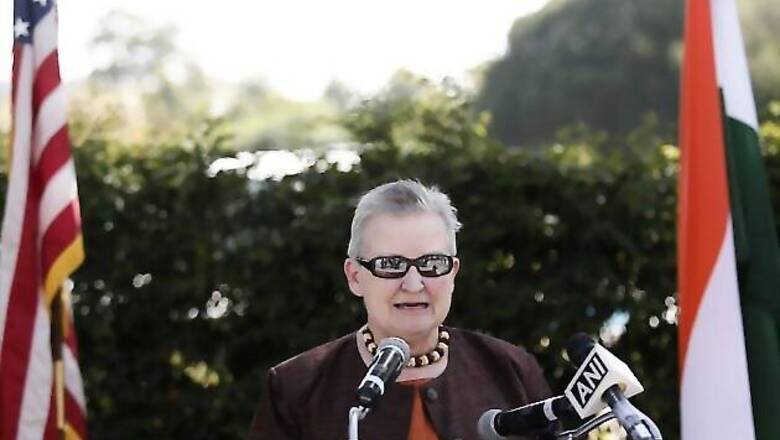
views
New Delhi: The US on Friday said that its bilateral trade with India can grow five-fold to $500 billion provided both the governments take "tough" and "vital" decisions in that direction.
Addressing an event in the national capital, Nancy Powell, who resigned from the post of US Ambassador to India earlier this month, said: "This will require both governments to make some tough, but vital, decisions...Yes, achieving $500 billion in bilateral goods and services trade will be challenging, but that should not hold us back from setting an ambitious goal".
Currently the bilateral stood at about $100 billion. The US-India Business Council (USIBC) had said bilateral trade between the countries could touch $500-billion mark over the next one decade. Suggesting if the borders of both nations are open to the free flow of capital, goods, services, technology, ideas, and innovation, Powell said there is no reason why trade will not flourish.
"Today, I challenge all of us, our governments, and leaders across politics, business, academia, and society to work together to realise the full potential of the US-India trading relationship.
"One possibility might be the convening of a Track 1.5 event during the first 100 days of the new Indian government to begin a conversation on how we can best accomplish this task," she said adding robust engagement is a cornerstone of a healthy bilateral relationship.
She also said: "While we are strongly opposed to forced local content requirements, we are sympathetic to the desire to develop a stronger manufacturing sector, and are ready to discuss how India might develop that capacity in a way that does not constrain trade".
"By the same token, we ask that India engage with the United States, at senior and working levels, to have those difficult discussions on issues such as intellectual property rights and taxation," she added. In February, the US has dragged India to WTO on the country's solar mission plan that allows only local equipment.
She said that to take the trade to $500 billion, both the sides can focus on sectors including civil aviation; defence; infrastructure; energy; healthcare; IT services and agriculture.
About defence sector, Powell said the segment continues to be an area of increased cooperation and great potential. "We want to help India in its efforts to modernise its military by co-producing and co-manufacturing the next generation of defence technology.
"When we make the same equipment, we operate the same equipment, and we also build connections that reinforce our overall defence relationship. Here is where prosperity blends into security as our defence collaboration contributes to our common interest to promote regional and global stability," she added.
Powell said that taking the bilateral trade to $500 billion would have significant impact on economies and citizens of both the countries. "To achieve this goal, however, we need to do much, much more to unlock the full economic potential of our bilateral relationship. Both countries need to implement policies that stimulate investment and trade.
"Some people point to the press headlines in both our countries describing challenges and frictions in our current trade relationship and are incredulous to hear us talk about the US and India reaching $500 billion in bilateral goods and services trade. Certainly achieving this goal will be no easy feat and could take many years to accomplish," she said.
She said that while the goal will have to be attained through the actions of private companies and individuals, there is much that governments can do to facilitate its accomplishment. For example, it is important to first nurture an environment that attracts growth, she said adding all investors evaluate transparency, predictability, infrastructure, and the labour force when making business decisions.
"As I prepare to retire from the Foreign Service, I am truly awed at the progress India has made over the past 20 years as well as by the depth and strength of the overall US-India relationship." I look forward to the day, not too far in the future, when a successor of mine will be able to announce that the US-India bilateral trade in goods and services topped $500 billion," she added.
In civil aviation, she said current government-to-government activity reflects US commitments to support aviation safety, security, training, and best practices.
She "India already manufactures significant volumes of aircraft components, and the joint venture between Tata Advanced Systems and United Technologies to manufacture aerospace components showcases the possibilities of Indo-US business ties. And with India expected to become the third largest aviation market in the world by 2020, there is ample room to grow," she said.
About infrastructure sector, Powell said this area is critical to India's future and it requires more than $1 trillion of investments in roads, rail, ports and information and communications technology infrastructure.
"The World Bank plans to loan $1 billion to India's rail sector. The US has valuable experience and technology in rail freight, with the largest railway network in the world. Let s work together to enhance India s railways".
"The state of India s current infrastructure poses a serious bottleneck to economic growth, and thus, to US trade and investment potential. A focus on addressing India's infrastructure needs will break open that bottleneck to improve the lives of Indian citizens and create jobs for both our economies," Powell said.
On the energy sector, the Ambassador said the US is a key partner for energy and power development in India. "Westinghouse and General Electric are prepared to develop 12,000 megawatts of nuclear power in Gujarat and Andhra Pradesh, potentially doubling India s ability to generate clean, safe, reliable nuclear power and generating billions of dollars of economic activity in both countries," she said.
In 2013, she said the US Department of Energy had approved a second project to export liquefied natural gas to India, which is likely to begin in 2017.
The 5.6 million tonnes of LNG contracted has a value of over $1.5 billion per year and could increase India s gas supply by as much as 40 per cent, she said.
About cooperation in healthcare, Powell said as India increases its per capita investment in public health, there will be new opportunities for US and Indian firms. Besides these sectors, she said cooperation in that other areas including agriculture, education and tourism would help in boosting trade.
"India has a growing population that will only increase enrolment demand here and in the United States, and there is untapped potential for US students to come to India," Powell said.
On tourism, she said that in 2013, 8,59,000 Indian tourists travelled to the US, and that number is expected to cross one million by 2015. "And Americans represent the largest group of foreign tourists to India, surpassing one million in 2013. India is a world class destination with tremendous potential to draw vastly greater numbers of tourists from America and around the world. By harnessing the opportunities in these and other sectors, reaching the $500 billion trade goal can become a reality," she added.



















Comments
0 comment